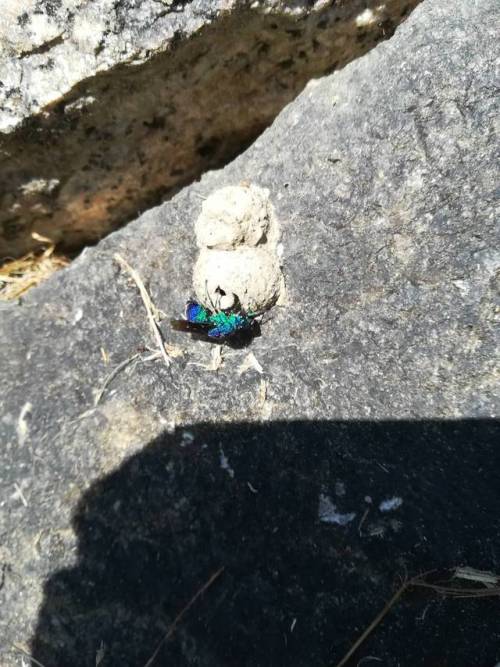#cuckoo wasp
Chrysis sp. “Cuckoo Wasp” Chrysididae
Missoula, MT
May 17, 2016
Robert Niese
Cuckoo Wasps are a massive, possibly polyphyletic group of parasitic wasps. More than half the members of this giant family are placed in the genus Chrysis(more than 1000 species!). Undoubtedly, in the coming years this genus will be stripped, split, and reorganized in favor of a more monophyletic and phylogenetically accurate set of genera. As their common name might suggest, cuckoo wasps lay their eggs in the nests of other wasps, and many specialize on a single host species. This lovely individual appeared to be waiting outside an old nail hole on the side of my house that was occupied by a cavity-nesting wasp of some sort.
Post link
“Saw this strange insect in Kyoto, going in and out of this nest structure. The colour struck me as very odd. I thought it was a weird bee or something at first, but upon closer inspection the head looks more fly-like. I was unable to identify it online, so I’m hoping someone else can!”
オオセイボウ(Stilbum cyanurum), Large Cuckoo Wasp
Hello!
Thanks so much for your submission. I hadn’t seen that handsome blue insect before, but your very helpful shot of its nest was enough to convince me I was looking at a wasp of some sort. So your first thought was absolutely right. I was able to ID it fairly certainly asStilbum cyanurum,https://en.wikipedia.org/wiki/Stilbum_cyanurum or in Japanese, オオセイボウ.(Ooseibou).
Comparison photos here:https://s2014no64.at.webry.info/201109/article_16.html
Distribution: Honshu, Shikoku, Kyushu, Okinawa
Size: 12 - 20 mm
It is indeed a type of Cuckoo Wasp. They have a stinger, but Cuckoo Wasps are not normally known to sting except in the most dire self-defense. Indeed, the photos on the blog above show someone handling it quite calmly. They’re widespread even across Europe, and though the adults feed on nectar like normal wasps, they capture and paralyze prey insects on which to lay their eggs in the nests. The larvae hatch out onto a ready meal.
Wonderful find and thank you for the submission!
Post link


